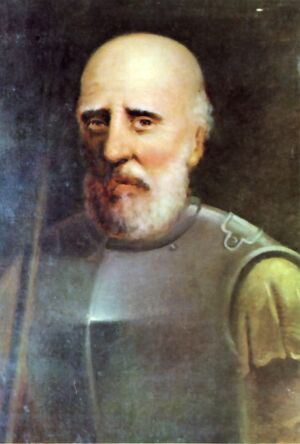فرانشسكو دى كارڤاخال
Francisco de Carvajal | |
|---|---|
 Francisco de Carvajal, conquistador of Peru. Museo Nacional de Historia, Lima. | |
| الكنية | El demonio de los Andes[1] |
| ولد | 1464 Rágama, Salamanca Province, Spain |
| توفي | 10 April 1548 Sacsayhuamán, Nueva Castilla, Peru |
| الولاء | |
| سنين الخدمة | 1480–1548 |
| الرتبة | Maestre de campo |
| المعارك/الحروب | War of the League of Cambrai |
Francisco de Carvajal (1464 – 10 April 1548) was a Spanish military officer, conquistador, and explorer remembered as "the demon of the Andes" due to his brutality and uncanny military skill in the Peruvian civil wars of the 16th century.[2]
Carvajal's career as a soldier in Europe spanned forty years and a half-dozen wars. Fighting in Spain's Imperial armies—the famous tercios—he served under Charles V's principal commanders in the Italian Wars: Pedro Navarro, Fabrizio Colonna, and the illustrious Gran Capitán, Gonzalo Fernández de Córdoba. He took part in the memorable Spanish victory at the Battle of Pavia in 1525 and acquired a small fortune when the Imperial armies sacked Rome two years later.
In the 1540s, the octogenarian Carvajal travelled to the Spanish West Indies and from there accepted a military commission with the Pizarro brothers in Peru, eventually backing Gonzalo Pizarro's unsuccessful rebellion against the officials of the Spanish Crown. Carvajal proved a tireless soldier and successful strategist. He was ultimately captured in battle by royalist forces on April 9, 1548 and executed at the age of 84.
كان احد الجنرالات والجلاديين للسكان الاصليين للامريكتين في فترة 1544 وخاض اكثر من 30 حرب في اوروباوامريكا وكان موجود اثناء نهب روما وقاتل في المكسيك مع فرانسيسكو بيزارو في البيرو وعبر سلسلة الجبال ست مرات
قاتلة دييغو سينتينوم وقبض علية وقتل بقطع راسة
الإعدام
Carvajal was sentenced to death by the royalists after being wounded and captured at the Battle of Jaquijahuana. American historian William H. Prescott collected a number of details about the execution, claiming that Carvajal was not gravely troubled by the sentence, remarking simply, "basta matar": "They can only kill me."[3] He refused confession offered by the priests and did not accept his last rites, asking:
But of what use would that be? I have nothing that lies heavy on my conscience, unless it be, indeed, the debt of half a real to a shopkeeper in Seville, which I forgot to pay before leaving the country.[3]
According to Prescott, Carvajal did admit guests throughout his last day but treated his interlocutors to his usual cutting sarcasm. When a former enemy, once vanquished in battle by Carvajal, came to offer his services to the condemned rebel, Carvajal rebuked him caustically:
And what service can you do me? Can you set me free? If you cannot do that, you can do nothing. If I spared your life, as you say, it was probably because I did not think it worthwhile to take it.[3]
Carvajal's only complaint emerged when his executioners arrived to carry him to the place of execution. Upon being bound and forced into a narrow basket, Carvajal exclaimed, "¡Niño en cuna y viejo en cuna!"—"Cradles for infants and now cradles for old men as well!"[3] Carvajal's severed head was exhibited on a pike next to Pizarro's at the gates of Lima.
Carvajal remains a folkloric character in Peru: One legend made him the illegitimate son of the Spanish-Italian tyrant Cesare Borgia; Ricardo Palma pointed out in the Tradiciones peruanas that Carvajal was in fact Borgia's senior by 10 years, their only parentage, he added, being "that of cruelty."
الهامش
- ^ Palma, p. 237, wrote that, por su indómita bravura, por sus dotes militares, por sus hazañas, que rayan en lo fantástico, por su rara fortuna en los combates y por su carácter sarcástico y cruel fué conocido, en los primeros tiempos del coloniaje, con el nombre de Demonio de los Andes.
- ^ Precott, p. 1217, notes, "With a character so extraordinary, with powers prolonged so far beyond the usual term of humanity, and passions so fierce in one tottering on the verge of the grave, it was not surprising that many fabulous stories should be eagerly circulating respecting him, and that Carvajal should be clothed with mysterious terrors as a sort of supernatural being,—the demon of the Andes!"
- ^ أ ب ت ث Prescott, p. 1214-1215
انظر أيضاً
- رواية سفر التكوين، إدواردو گاليانو، ترجمة أسامة إسبر، ص. 99-102.
المراجع
- Palma, Ricardo (1997), Tradiciones peruanas, EdUSP, ISBN 84-89666-22-9.
- Prescott, William Hickling (2004), The Conquest of Peru, Digital Antiquaria, ISBN 1-58057-302-9.
- مواليد 1464
- وفيات 1548
- People from the Province of Salamanca
- كونكيستادورات اسبان
- Castilian-Leonese conquistadors
- مستكشفون اسبان
- Spanish generals
- إسپان من القرن 16
- People of the Italian Wars
- Colonial Peru
- Spanish rebels
- People executed by New Spain
- Executed military personnel
- اسبان أعدموا في الخارج
- People executed for treason against Spain
- Executed Spanish people
- Castilian conquistadors
- People executed by Spain by decapitation
- 16th-century Peruvian people
- University of Salamanca alumni